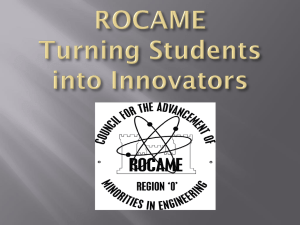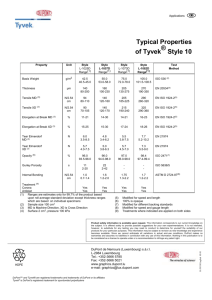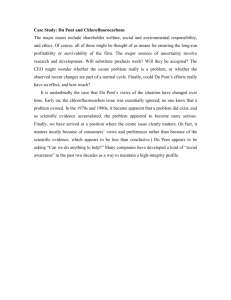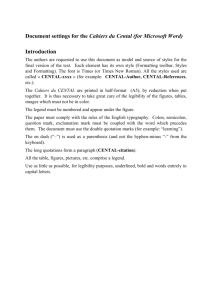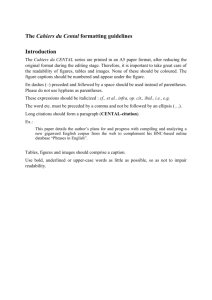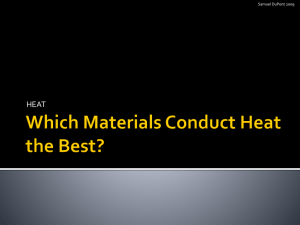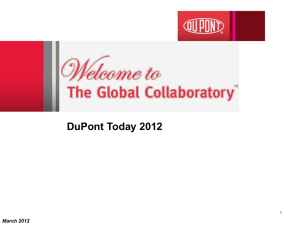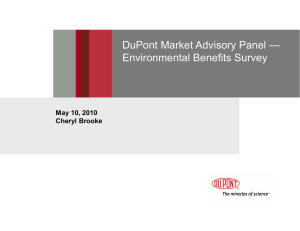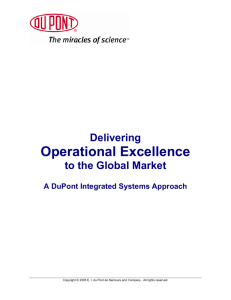Preemptive Capacity Expansion in the Titanium Dioxide Industry
advertisement
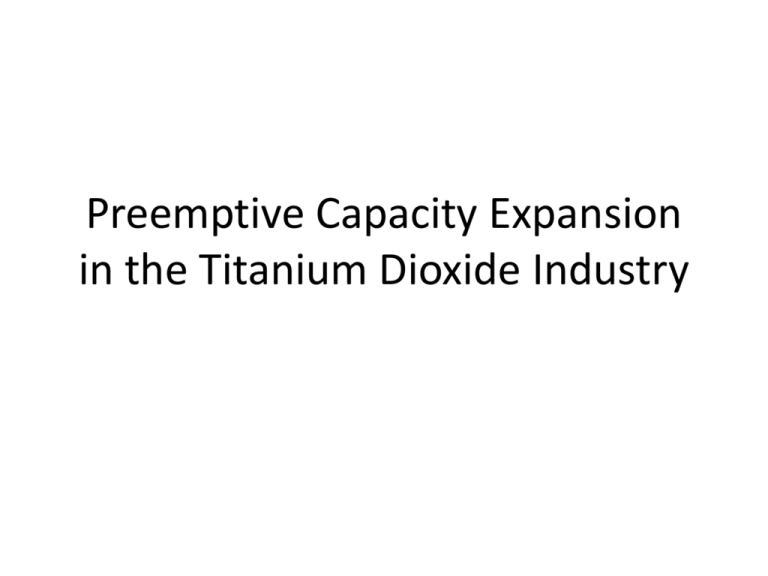
Preemptive Capacity Expansion in the Titanium Dioxide Industry Titanium Dioxide • Utilized in paper, plastic, paints industries as a whitener. • It is a commodity • Inelastic demand (-0,3 in the 70ies). It is a small cost component. Quality is important. Titanium Dioxide industry(1) Total industry capacity 770,000 tons firms Market Share Dupont 34% National Lead 23% American Cyanamid 14% SCM 10% Gulf & Western 9% Kerr McGee 6% Sherwin-Williams 4% Titanium Dioxide industry (2) Three Technologies: Sulphate Batch Process (low-grade Ilmenite ore) Cloride continuous process (high-grade rutile) (low-grade Ilmenite ore) Only Du Pont aperates 2/3 ot its total capacity Titanium Dioxide industry(3) ChlorideIlmenite Chloride-Rutile Sulfate Ore 2.5 3.5 2.5 Other igredients 3.9 2.9 3.7 Energy 1.5 1.5 2.9 Labour 1.9 2.9 3.7 Miscellaneous 4.6 4.6 4.1 Capital 3. 2.5 4.0 Waste disposal 0.2 0.1 0.3 17.6 18.0 21.2 Production costs 1972 Source: Applied Industrial Economics , Philips L., Cambridge University Press, 1998, pag. 71 1970 – 1971 Environmental shocks - AUSTRALIA restriction on mining Rutile from beach sands price. Rutile price up 70%, lower price increase for Ilmenite - US more stringent emission standards hitting mainly the sulfate process, the dirtiest of the three. Cost increase • standard costs increase: • 10 % Cloride continuous process (Ilmenite) • 20 % Cloride continuous process (Rutile) • 20 % Sulphate Batch Process • Economy of Scale: with a double productive capacity for production plant: • 7,5% Sulphate Batch Process • 14,3% Cloride continuous process The story: Du Pont strategy Early seventies: small productive capacity expansion policy (slow) May 1972 one shot opportunity to increase market share and became undisputed market leader. Aggressive policy to expand productive capacity to cover all the extra demand that will be created in the ‘70 and ’80 (fast) Slow policy: market share grows +7% Fast policy: • New large production plan in DeLisle (clorite Ilmenite) 200.000 ton • New production lines in other sites. Market Share form 30% in 1970 to 65% in 1985 Given the long authorization process and construction times needed to build a chemical plant, the first production lines in DeLisle was planned to be ready in 1977 while the second will be built 2 or 3 years later. The story In 1975 DuPont has to change his productive expansion project for several reasons: Demand was not growing as expected as in 1972; Pollution controls were not binding as expected, so competitors with the highly polluting sulfate process continued to operate. Low capacity utilization, sharp increase in construction and chlorine costs heavily deteriorated cash flow (Du Pont didn’t what to increase prices). This was a real concern because DuPont didn't want to lose is AAA rating at corporate level. Need a change of strategy An internal task force of DuPont’s Pigments department analyzed the financial implications of two long run strategies: a) Maintain Strategy (M): goal is 43% market share before 1985. this strategy only needs capacity expansion in already operating production plants. b) Modified grow strategy (G): goal is 55% market share in 1985, with the construction of the first production line in DeLisle in ‘78 –’79. Strategy Start-up date DuPont’s 1985 share Others’ expansions: 1975-1981 Maintain postponed 43% 160.000 tons DuPont discounted cash flow: 1975-1984 $14 million Growth A 1978 – Q3 < 55% 110.000 tons $53 million Growth B 1979 – Q4 55% 50.000 tons $73 million . Strategy comparison Why simulations show that growth’s strategies are better than the maintain one? With (G) strategies short run prices will be lower than with (M) strategy due to excess capacity. With (M) strategy some competitors could increase productive capacity (as announced by McGee). Long run prices should be higher (3%) compared to (M) because (G) should prevent others expansion so Du Pont will be market leader with a stronger market power. Research question: is productive capacity expansion explained by differences in cost efficiency or DuPont wants to preempt the market (GT) ? Not so easy • Yes DuPonts seems to build up capacity ahead of demand • But this could be rationalized by the huge cost advantage • And by the perceived need of new capacity after 1975 • Don’t forget sunk costs… • Is 3% big? Ghemawat model First consider 3% (1) It is possible that the Net Present Value of a growth strategy without elevated prices (H) would come close to the NPV of G Define Vi the NPV of a strategy i Define Δ = VG – VH* If (1) is true Δ should be small Unfortunately we don’t know VH* but we can find a proxy for VH* focusing on an hybrid strategy H’ that combines capacity and output of G with the long run prices of M Δ’ = VG – VH’* Δ = VG – VH* Δ’ = VG – VH’* First approach DuPont picks G instead of M so r has to be lower than 19,6%. Note: Δ strictly decreasing in r The power of push up prices was worth more than Δ’ (19,6) =$42 million Second approach VG (r) – Δ’ (r) < VM (r) true if r≥13,2% 19,6 We can attach a probability 13,2 𝑔 𝑟 𝑑(𝑟) To the belief that DuPont picket G instead of M only because it thought that G would help to push up prices Given that AAA corporate bonds where running at 7.3 – 8.8 % we can guess that the probability is close to 1 Theoretical analysis: Ghemawat model • Two firms with different initial capacities 𝑘1 >𝑘2 • In the long run (stage 1) they compete on productive capacity (to add an efficiently scaled plant) , in the short run (stage 2) they compete on prices • we work backward from stage 2 to stage 1 • Inelastic demand • (short run look at the one period model of the Turbine Chapter) Uniperiodal model (stage 2) Q are at the same time on the market (or duopolists have to fix prices ex ante) Proposition 2.1 Given that x1≥x2 and defining j the one is not i a. if Q ≤ x2 The only equilibrium price is p1=p2 =0 and revenue i =0 b. if x2<Q< x1there is only one equilibrium in mixed strategies The price i probability distribution is supported by: (u(Q-x2)/Q,u] and ψi = [1 − 𝑢(𝑄−x2) ]∙ 𝑝𝑄 𝑄 max( ) xi Uniperiodal model (STAGE 2) xi Revenues of firm i = u(Q-x2). min ( ,1) 𝑄 c. If x1≤Q<x1 + x2 d. if Q ≥ x1 + x2 p1=p2=u From this we can identify the relation between the industry’s expected operating profits and its concentration level What we want to prove: If 𝑥2 <Q< 𝑥1 + 𝑥2 + 1 , the industry’s expected operating profits are higher the grater is the share of aggregate capacity accounted for, by the larger firm, firm i. Proof X aggregate capacity X= 𝑘1 + 𝑘2 +1 = 𝑥1 + 𝑥2 X constant - 𝑥𝑗 =X-𝑥𝑖 𝑅1 = 𝑢 𝑄 − 𝑋 + 𝑥1 𝑑𝑅𝑖 =u 𝑑𝑋𝑖 Q< 𝑥𝑖 smaller firm operating profits 𝑋 − 𝑥𝑖 𝑅𝑗 = 𝑢 𝑄 − 𝑋 + 𝑥𝑖 𝑄 𝑑𝑅𝑗 𝑑𝑋𝑖 =u 2𝑋−2𝑥𝑖 −𝑄 𝑄 equal -1 only if the limit capacity of the small one is very small, other way is bigger than -1 If Q≥ 𝑥𝑖 smaller firm’s expected operating profits are: 𝑅𝑗 = 𝑢 𝑄 − 𝑋 + 𝑥𝑖 𝑑𝑅𝑗 𝑑𝑋𝑖 =u 𝑋2 −𝑄𝑋 𝑥𝑖 2 𝑋 − 𝑥𝑖 𝑥𝑖 −1 is always greater than -1 given that X>Q so 𝑑(𝑅𝑗+𝑅𝑖) 𝑑𝑋𝑖 ≥0 =0 only when Q less than 𝑥𝑖 and 𝑥𝑗 =0 Stage 1: add an efficiently scaled plant Consider it like an auction process were firms bid for the right to build a new plant We want to prove that: If 𝑥2 < Q < 𝑥1 + 𝑥2 + 1 and competitors are risk neutral, firm 1, which is initially larger, is willing to bid strictly more for the additional unit of capacity Proof The maximum price firm i is willing to bid for the additional unit of capacity is given by: 𝑉𝑖 (𝑥𝑖 + 𝑥𝑗 )=𝑅𝑖 (𝑥𝑖 + 1, 𝑥𝑗 )-𝑅𝑖 (𝑥𝑖 , 𝑥𝑗 + 1) But as we proved in stage 2 (proposition 3.1 in the book) 𝑅1 (𝑥1 + 1, 𝑥2 )+𝑅2 (𝑥2 , 𝑥1 + 1)> 𝑅1 (𝑥1 , 𝑥2 +1)+𝑅2 (𝑥2 + 1, 𝑥1 ) Rearranging: 𝑅1 (𝑥1 + 1, 𝑥2 ) -𝑅1 𝑥1 , 𝑥2 +1 > 𝑅2 (𝑥2 + 1, 𝑥1 ) − 𝑅2 (𝑥2 , 𝑥1 + 1) 𝑉1 (𝑥1 , 𝑥2 )>𝑉2 (𝑥2 , 𝑥1 ) Reflections: Models of capacity expansion Different models: Kreps and Scheinkman (1983): same structure but in period 1 both firms chose productive capacity at the same time => shares of duopolist converge. But in this case the announcement of the De Lisle investment make us think that the Ghemawat model is better Reflections: Models of capacity expansion • Uncertainty doesn’t change outcomes • Private information can change outcome (but we can end in a winner’s curse) see Ghemawat 1987. • Limit pricing? DuPont try to keep prices low to deter capacity expansion by competitors, counting on behavioral response involving capital constraints Reflections: Models of capacity expansion Also old IO had similar implications: Titanium Dioxide Industry exhibits many of the structural conditions that THE Old IO identified as conducive to preemption • Supply side: large minimal efficient scales, experience curve (learning by doing), high capital intensity • Demand side: low price elasticity, convergent expectations, modest growth rates. (see Porter chap. 15 (1980) Reflections: Resource-based view Definitely has some unique resources (technology, competence, etc,) 1. What are the precondition that a resource must fulfill in order to be a source of Sustainable Competitive Advantage (SCA)? In general RB theory very vague (valuable and rare?). In this case DuPont has source of SCA: durability and specialization 2. How do firms manage to accumulate SCA? Not only luck…DuPont was only lucky with the 1971 environmental shocks? No! they invested in a new technology to have a competitive advantage using superior corporate technical capabilities. 3. How do superior resources evolve over time? Es. Learning by doing 4. How are such big, relatively irreversible decisions to be analyzed? (RB looks internally at the firms). DuPont case contradicts this. Du Pont identified, evaluated, and elected to persist with the strategy of starting up De Lisle on the basis of detailed comparisons of its costs with the competitors. It analyzed long-run resource commitments by anticipating their implication for product market interactions 5. Why not quick imitations of superior resources? For RB, intrinsic inimitability, historical circumstances, social complexity, etc. This case shows that sometime imitation is possible but uneconomical . Du Pont thinks that it could be imitated but knows there is room for only one new efficient plant. Summary • Du Pont apparently expanded capacity preemptively to have higher prices in the long run. We need GT to rationalize this process. • Model’s selection is very important • GT can complement RB theory.

